Curriculum Design Report for Digital Marketing Module, Semester 1
VerifiedAdded on 2023/06/08
|21
|5767
|86
Report
AI Summary
This report delves into the intricacies of curriculum design and development, with a specific focus on digital marketing. It begins with an exploration of the purpose of curriculum development, highlighting its academic, social, economic, and political dimensions. The report then examines various models and approaches to curriculum design, including subject-centered, learner-centered, and problem-centered approaches, along with detailed analysis of the Tyler and Stenhouse models. A significant portion of the report addresses the importance of learner feedback, risk management strategies, and methodologies for evaluating and monitoring curriculum effectiveness. The second task provides a curriculum design for an Advanced Diploma in Digital Marketing program, outlining the course aims, objectives, assessment methods, and resources. Finally, the report explores the characteristics, attributes, uses, and benefits of social media marketing within the digital marketing context, thus providing a comprehensive overview of curriculum development in the field.
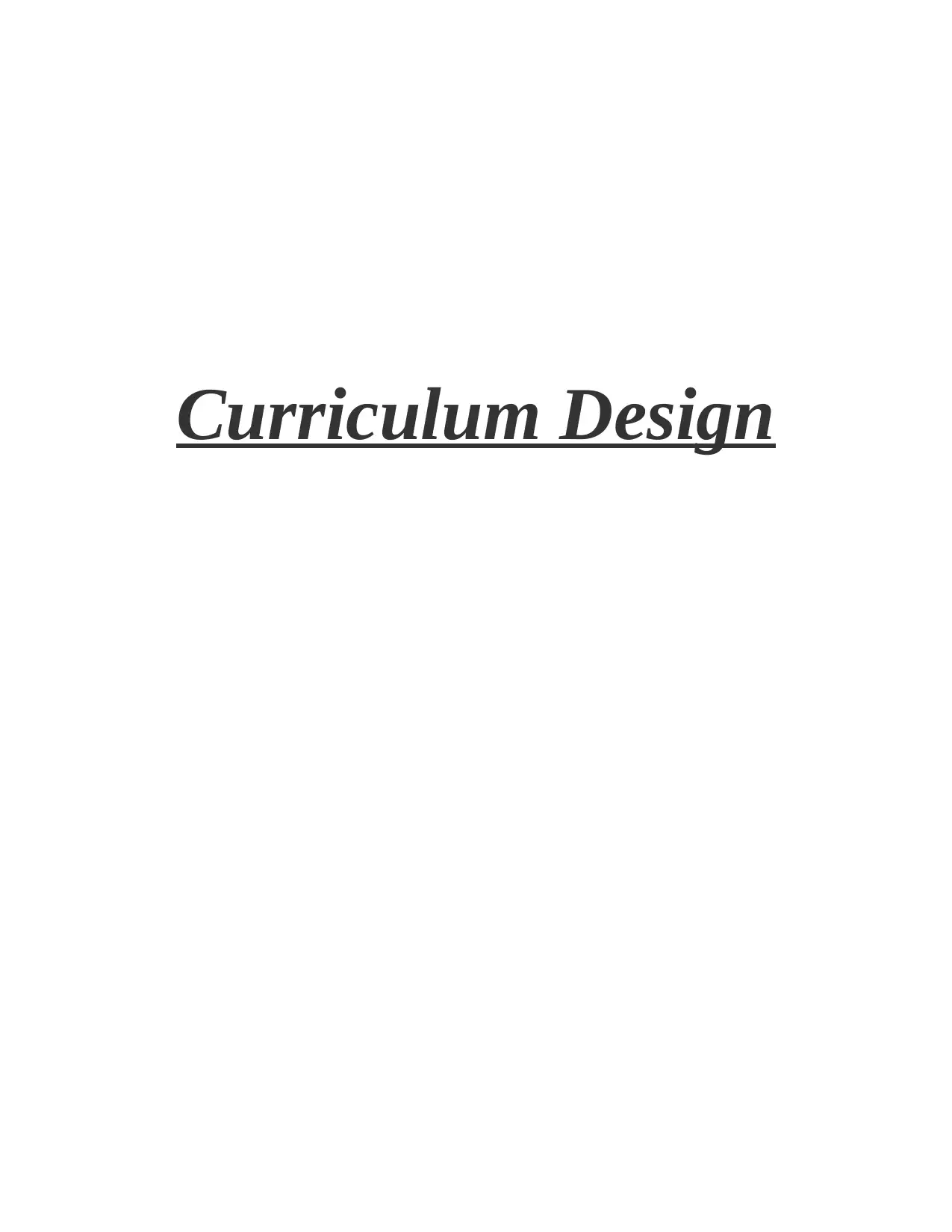
Curriculum Design
Paraphrase This Document
Need a fresh take? Get an instant paraphrase of this document with our AI Paraphraser
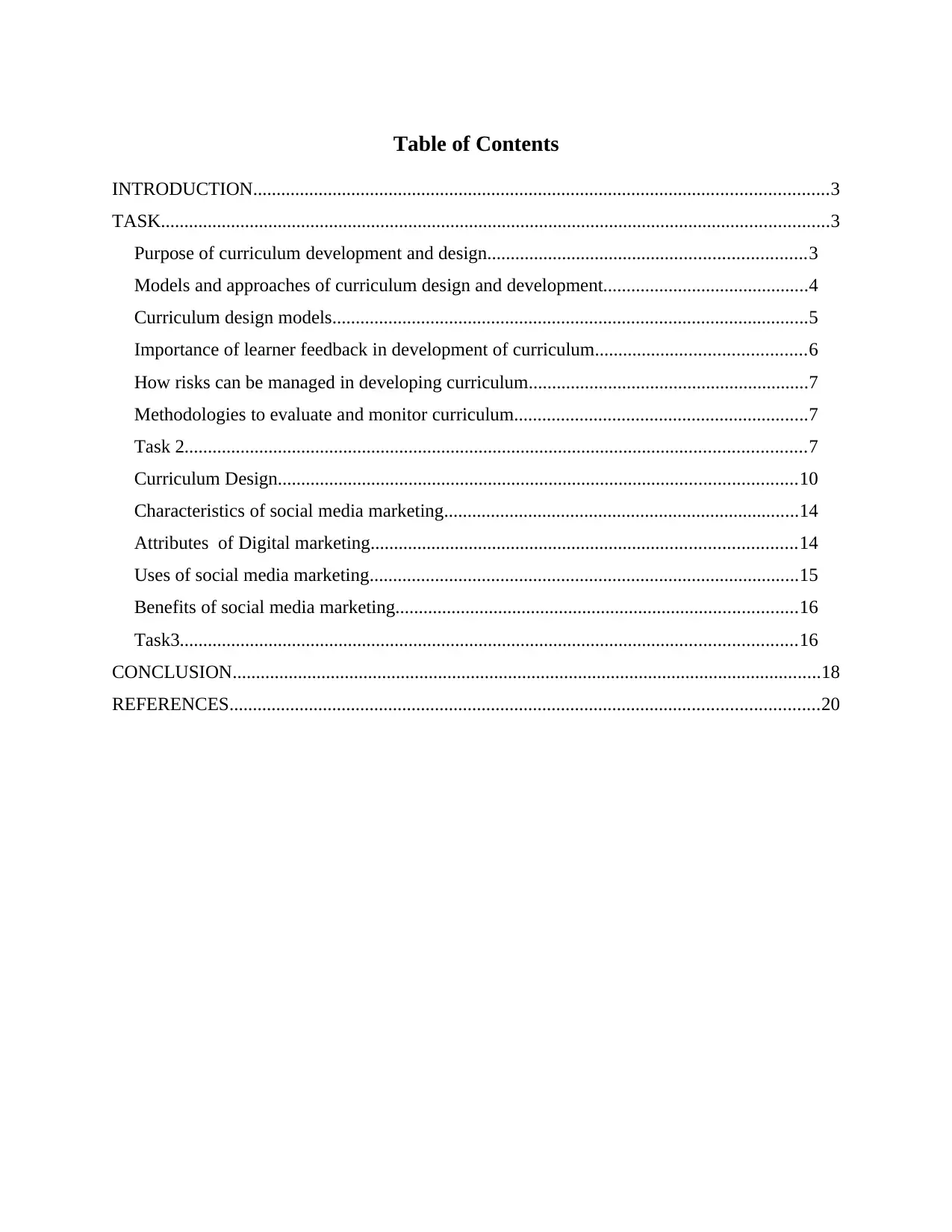
Table of Contents
INTRODUCTION...........................................................................................................................3
TASK...............................................................................................................................................3
Purpose of curriculum development and design....................................................................3
Models and approaches of curriculum design and development............................................4
Curriculum design models......................................................................................................5
Importance of learner feedback in development of curriculum.............................................6
How risks can be managed in developing curriculum............................................................7
Methodologies to evaluate and monitor curriculum...............................................................7
Task 2.....................................................................................................................................7
Curriculum Design...............................................................................................................10
Characteristics of social media marketing............................................................................14
Attributes of Digital marketing...........................................................................................14
Uses of social media marketing............................................................................................15
Benefits of social media marketing......................................................................................16
Task3....................................................................................................................................16
CONCLUSION..............................................................................................................................18
REFERENCES..............................................................................................................................20
INTRODUCTION...........................................................................................................................3
TASK...............................................................................................................................................3
Purpose of curriculum development and design....................................................................3
Models and approaches of curriculum design and development............................................4
Curriculum design models......................................................................................................5
Importance of learner feedback in development of curriculum.............................................6
How risks can be managed in developing curriculum............................................................7
Methodologies to evaluate and monitor curriculum...............................................................7
Task 2.....................................................................................................................................7
Curriculum Design...............................................................................................................10
Characteristics of social media marketing............................................................................14
Attributes of Digital marketing...........................................................................................14
Uses of social media marketing............................................................................................15
Benefits of social media marketing......................................................................................16
Task3....................................................................................................................................16
CONCLUSION..............................................................................................................................18
REFERENCES..............................................................................................................................20
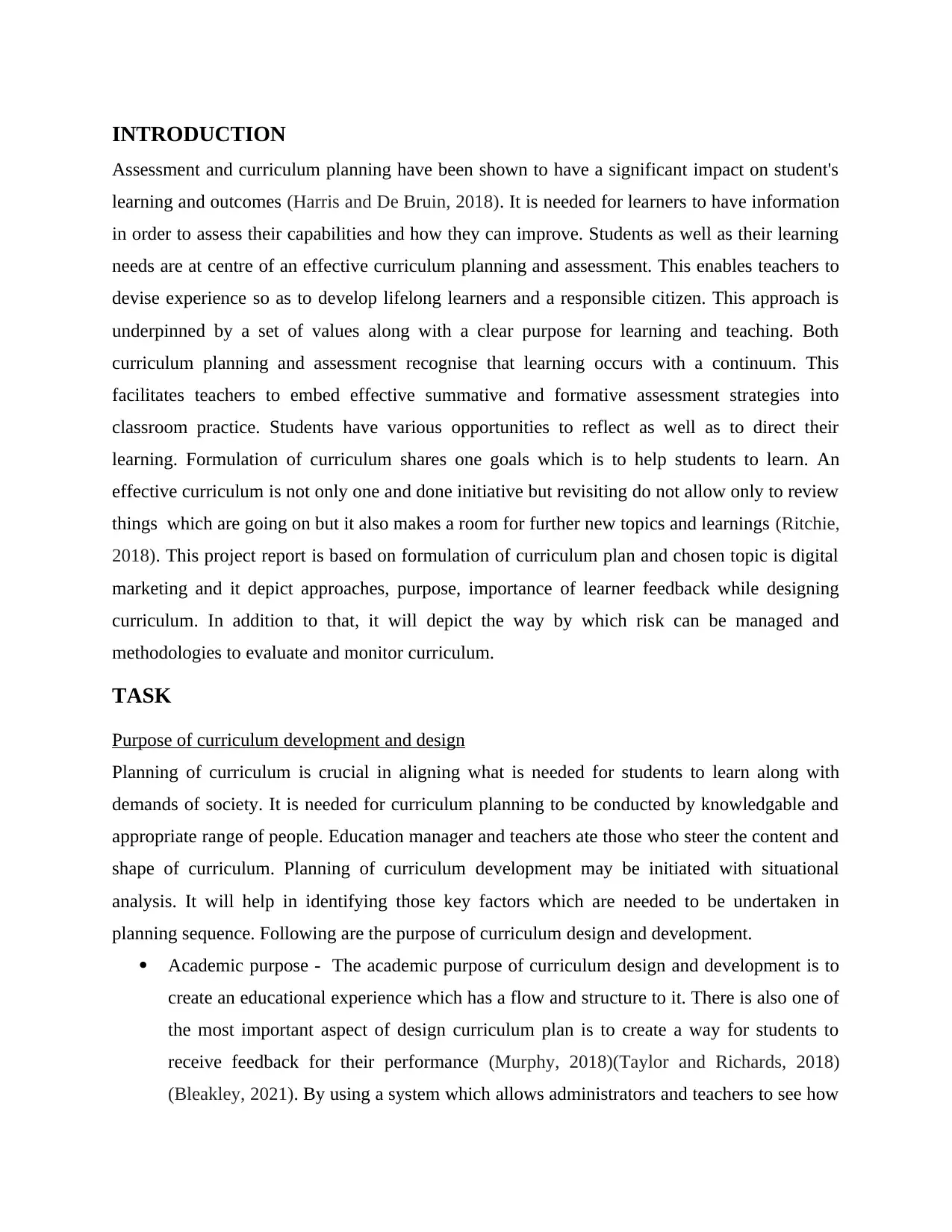
INTRODUCTION
Assessment and curriculum planning have been shown to have a significant impact on student's
learning and outcomes (Harris and De Bruin, 2018). It is needed for learners to have information
in order to assess their capabilities and how they can improve. Students as well as their learning
needs are at centre of an effective curriculum planning and assessment. This enables teachers to
devise experience so as to develop lifelong learners and a responsible citizen. This approach is
underpinned by a set of values along with a clear purpose for learning and teaching. Both
curriculum planning and assessment recognise that learning occurs with a continuum. This
facilitates teachers to embed effective summative and formative assessment strategies into
classroom practice. Students have various opportunities to reflect as well as to direct their
learning. Formulation of curriculum shares one goals which is to help students to learn. An
effective curriculum is not only one and done initiative but revisiting do not allow only to review
things which are going on but it also makes a room for further new topics and learnings (Ritchie,
2018). This project report is based on formulation of curriculum plan and chosen topic is digital
marketing and it depict approaches, purpose, importance of learner feedback while designing
curriculum. In addition to that, it will depict the way by which risk can be managed and
methodologies to evaluate and monitor curriculum.
TASK
Purpose of curriculum development and design
Planning of curriculum is crucial in aligning what is needed for students to learn along with
demands of society. It is needed for curriculum planning to be conducted by knowledgable and
appropriate range of people. Education manager and teachers ate those who steer the content and
shape of curriculum. Planning of curriculum development may be initiated with situational
analysis. It will help in identifying those key factors which are needed to be undertaken in
planning sequence. Following are the purpose of curriculum design and development.
Academic purpose - The academic purpose of curriculum design and development is to
create an educational experience which has a flow and structure to it. There is also one of
the most important aspect of design curriculum plan is to create a way for students to
receive feedback for their performance (Murphy, 2018)(Taylor and Richards, 2018)
(Bleakley, 2021). By using a system which allows administrators and teachers to see how
Assessment and curriculum planning have been shown to have a significant impact on student's
learning and outcomes (Harris and De Bruin, 2018). It is needed for learners to have information
in order to assess their capabilities and how they can improve. Students as well as their learning
needs are at centre of an effective curriculum planning and assessment. This enables teachers to
devise experience so as to develop lifelong learners and a responsible citizen. This approach is
underpinned by a set of values along with a clear purpose for learning and teaching. Both
curriculum planning and assessment recognise that learning occurs with a continuum. This
facilitates teachers to embed effective summative and formative assessment strategies into
classroom practice. Students have various opportunities to reflect as well as to direct their
learning. Formulation of curriculum shares one goals which is to help students to learn. An
effective curriculum is not only one and done initiative but revisiting do not allow only to review
things which are going on but it also makes a room for further new topics and learnings (Ritchie,
2018). This project report is based on formulation of curriculum plan and chosen topic is digital
marketing and it depict approaches, purpose, importance of learner feedback while designing
curriculum. In addition to that, it will depict the way by which risk can be managed and
methodologies to evaluate and monitor curriculum.
TASK
Purpose of curriculum development and design
Planning of curriculum is crucial in aligning what is needed for students to learn along with
demands of society. It is needed for curriculum planning to be conducted by knowledgable and
appropriate range of people. Education manager and teachers ate those who steer the content and
shape of curriculum. Planning of curriculum development may be initiated with situational
analysis. It will help in identifying those key factors which are needed to be undertaken in
planning sequence. Following are the purpose of curriculum design and development.
Academic purpose - The academic purpose of curriculum design and development is to
create an educational experience which has a flow and structure to it. There is also one of
the most important aspect of design curriculum plan is to create a way for students to
receive feedback for their performance (Murphy, 2018)(Taylor and Richards, 2018)
(Bleakley, 2021). By using a system which allows administrators and teachers to see how
⊘ This is a preview!⊘
Do you want full access?
Subscribe today to unlock all pages.

Trusted by 1+ million students worldwide
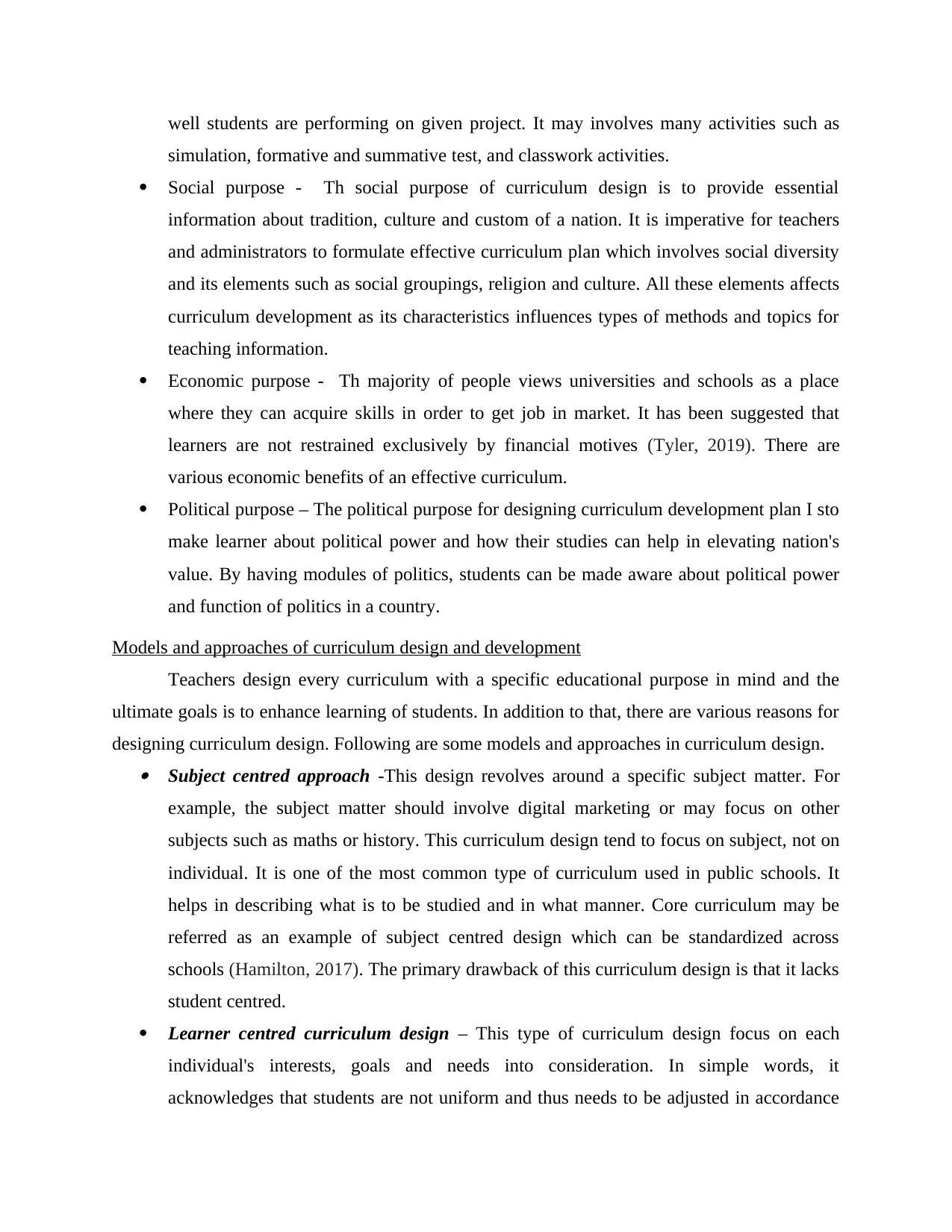
well students are performing on given project. It may involves many activities such as
simulation, formative and summative test, and classwork activities.
Social purpose - Th social purpose of curriculum design is to provide essential
information about tradition, culture and custom of a nation. It is imperative for teachers
and administrators to formulate effective curriculum plan which involves social diversity
and its elements such as social groupings, religion and culture. All these elements affects
curriculum development as its characteristics influences types of methods and topics for
teaching information.
Economic purpose - Th majority of people views universities and schools as a place
where they can acquire skills in order to get job in market. It has been suggested that
learners are not restrained exclusively by financial motives (Tyler, 2019). There are
various economic benefits of an effective curriculum.
Political purpose – The political purpose for designing curriculum development plan I sto
make learner about political power and how their studies can help in elevating nation's
value. By having modules of politics, students can be made aware about political power
and function of politics in a country.
Models and approaches of curriculum design and development
Teachers design every curriculum with a specific educational purpose in mind and the
ultimate goals is to enhance learning of students. In addition to that, there are various reasons for
designing curriculum design. Following are some models and approaches in curriculum design. Subject centred approach -This design revolves around a specific subject matter. For
example, the subject matter should involve digital marketing or may focus on other
subjects such as maths or history. This curriculum design tend to focus on subject, not on
individual. It is one of the most common type of curriculum used in public schools. It
helps in describing what is to be studied and in what manner. Core curriculum may be
referred as an example of subject centred design which can be standardized across
schools (Hamilton, 2017). The primary drawback of this curriculum design is that it lacks
student centred.
Learner centred curriculum design – This type of curriculum design focus on each
individual's interests, goals and needs into consideration. In simple words, it
acknowledges that students are not uniform and thus needs to be adjusted in accordance
simulation, formative and summative test, and classwork activities.
Social purpose - Th social purpose of curriculum design is to provide essential
information about tradition, culture and custom of a nation. It is imperative for teachers
and administrators to formulate effective curriculum plan which involves social diversity
and its elements such as social groupings, religion and culture. All these elements affects
curriculum development as its characteristics influences types of methods and topics for
teaching information.
Economic purpose - Th majority of people views universities and schools as a place
where they can acquire skills in order to get job in market. It has been suggested that
learners are not restrained exclusively by financial motives (Tyler, 2019). There are
various economic benefits of an effective curriculum.
Political purpose – The political purpose for designing curriculum development plan I sto
make learner about political power and how their studies can help in elevating nation's
value. By having modules of politics, students can be made aware about political power
and function of politics in a country.
Models and approaches of curriculum design and development
Teachers design every curriculum with a specific educational purpose in mind and the
ultimate goals is to enhance learning of students. In addition to that, there are various reasons for
designing curriculum design. Following are some models and approaches in curriculum design. Subject centred approach -This design revolves around a specific subject matter. For
example, the subject matter should involve digital marketing or may focus on other
subjects such as maths or history. This curriculum design tend to focus on subject, not on
individual. It is one of the most common type of curriculum used in public schools. It
helps in describing what is to be studied and in what manner. Core curriculum may be
referred as an example of subject centred design which can be standardized across
schools (Hamilton, 2017). The primary drawback of this curriculum design is that it lacks
student centred.
Learner centred curriculum design – This type of curriculum design focus on each
individual's interests, goals and needs into consideration. In simple words, it
acknowledges that students are not uniform and thus needs to be adjusted in accordance
Paraphrase This Document
Need a fresh take? Get an instant paraphrase of this document with our AI Paraphraser
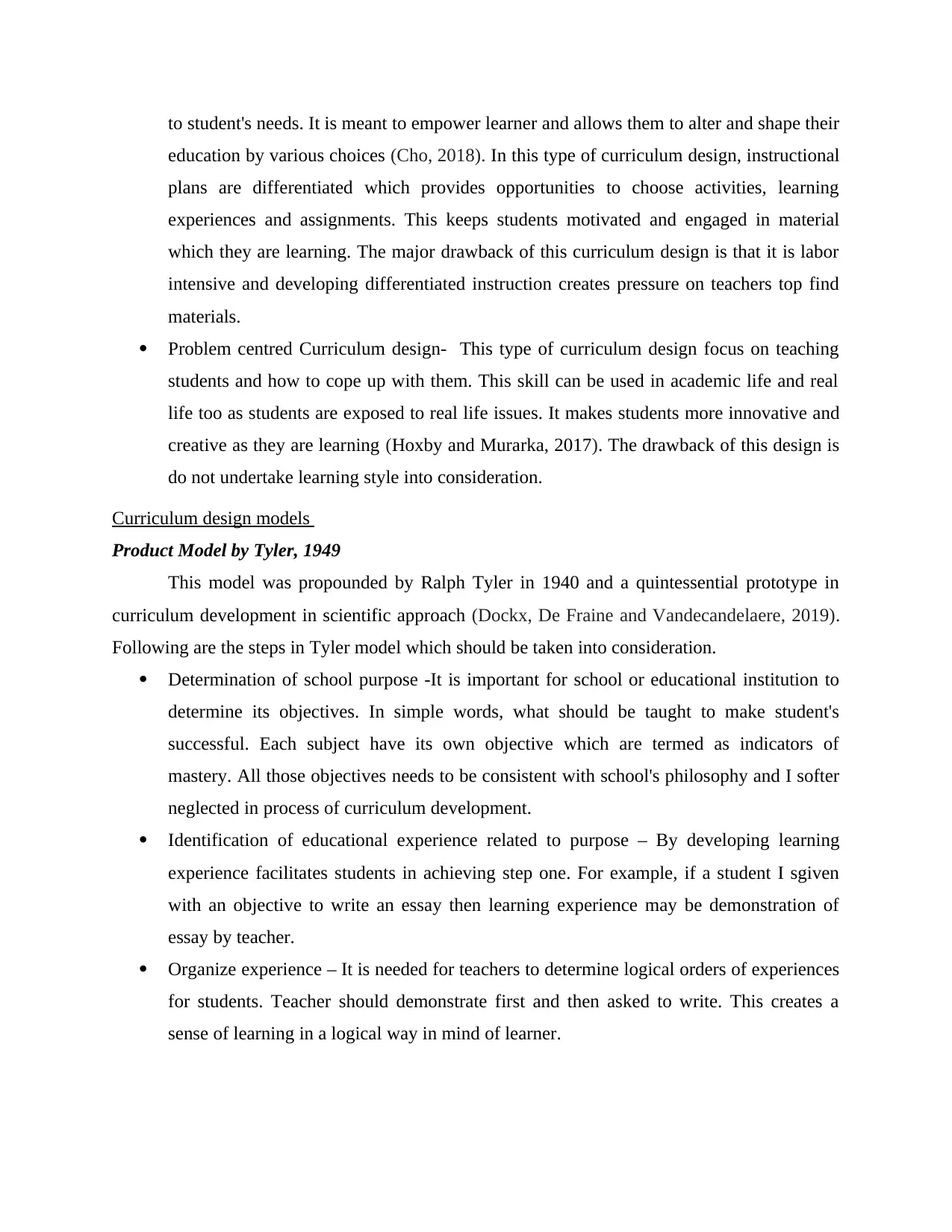
to student's needs. It is meant to empower learner and allows them to alter and shape their
education by various choices (Cho, 2018). In this type of curriculum design, instructional
plans are differentiated which provides opportunities to choose activities, learning
experiences and assignments. This keeps students motivated and engaged in material
which they are learning. The major drawback of this curriculum design is that it is labor
intensive and developing differentiated instruction creates pressure on teachers top find
materials.
Problem centred Curriculum design- This type of curriculum design focus on teaching
students and how to cope up with them. This skill can be used in academic life and real
life too as students are exposed to real life issues. It makes students more innovative and
creative as they are learning (Hoxby and Murarka, 2017). The drawback of this design is
do not undertake learning style into consideration.
Curriculum design models
Product Model by Tyler, 1949
This model was propounded by Ralph Tyler in 1940 and a quintessential prototype in
curriculum development in scientific approach (Dockx, De Fraine and Vandecandelaere, 2019).
Following are the steps in Tyler model which should be taken into consideration.
Determination of school purpose -It is important for school or educational institution to
determine its objectives. In simple words, what should be taught to make student's
successful. Each subject have its own objective which are termed as indicators of
mastery. All those objectives needs to be consistent with school's philosophy and I softer
neglected in process of curriculum development.
Identification of educational experience related to purpose – By developing learning
experience facilitates students in achieving step one. For example, if a student I sgiven
with an objective to write an essay then learning experience may be demonstration of
essay by teacher.
Organize experience – It is needed for teachers to determine logical orders of experiences
for students. Teacher should demonstrate first and then asked to write. This creates a
sense of learning in a logical way in mind of learner.
education by various choices (Cho, 2018). In this type of curriculum design, instructional
plans are differentiated which provides opportunities to choose activities, learning
experiences and assignments. This keeps students motivated and engaged in material
which they are learning. The major drawback of this curriculum design is that it is labor
intensive and developing differentiated instruction creates pressure on teachers top find
materials.
Problem centred Curriculum design- This type of curriculum design focus on teaching
students and how to cope up with them. This skill can be used in academic life and real
life too as students are exposed to real life issues. It makes students more innovative and
creative as they are learning (Hoxby and Murarka, 2017). The drawback of this design is
do not undertake learning style into consideration.
Curriculum design models
Product Model by Tyler, 1949
This model was propounded by Ralph Tyler in 1940 and a quintessential prototype in
curriculum development in scientific approach (Dockx, De Fraine and Vandecandelaere, 2019).
Following are the steps in Tyler model which should be taken into consideration.
Determination of school purpose -It is important for school or educational institution to
determine its objectives. In simple words, what should be taught to make student's
successful. Each subject have its own objective which are termed as indicators of
mastery. All those objectives needs to be consistent with school's philosophy and I softer
neglected in process of curriculum development.
Identification of educational experience related to purpose – By developing learning
experience facilitates students in achieving step one. For example, if a student I sgiven
with an objective to write an essay then learning experience may be demonstration of
essay by teacher.
Organize experience – It is needed for teachers to determine logical orders of experiences
for students. Teacher should demonstrate first and then asked to write. This creates a
sense of learning in a logical way in mind of learner.
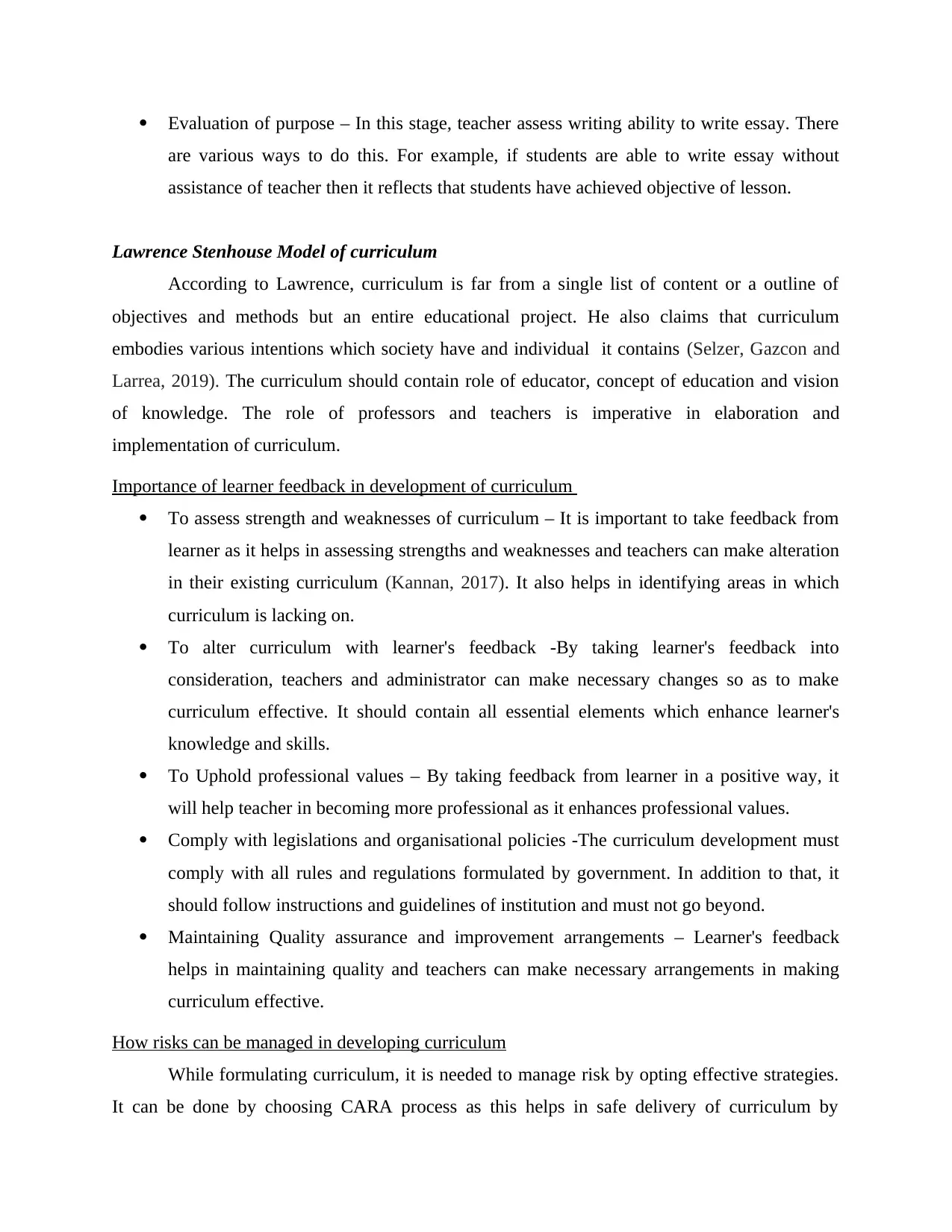
Evaluation of purpose – In this stage, teacher assess writing ability to write essay. There
are various ways to do this. For example, if students are able to write essay without
assistance of teacher then it reflects that students have achieved objective of lesson.
Lawrence Stenhouse Model of curriculum
According to Lawrence, curriculum is far from a single list of content or a outline of
objectives and methods but an entire educational project. He also claims that curriculum
embodies various intentions which society have and individual it contains (Selzer, Gazcon and
Larrea, 2019). The curriculum should contain role of educator, concept of education and vision
of knowledge. The role of professors and teachers is imperative in elaboration and
implementation of curriculum.
Importance of learner feedback in development of curriculum
To assess strength and weaknesses of curriculum – It is important to take feedback from
learner as it helps in assessing strengths and weaknesses and teachers can make alteration
in their existing curriculum (Kannan, 2017). It also helps in identifying areas in which
curriculum is lacking on.
To alter curriculum with learner's feedback -By taking learner's feedback into
consideration, teachers and administrator can make necessary changes so as to make
curriculum effective. It should contain all essential elements which enhance learner's
knowledge and skills.
To Uphold professional values – By taking feedback from learner in a positive way, it
will help teacher in becoming more professional as it enhances professional values.
Comply with legislations and organisational policies -The curriculum development must
comply with all rules and regulations formulated by government. In addition to that, it
should follow instructions and guidelines of institution and must not go beyond.
Maintaining Quality assurance and improvement arrangements – Learner's feedback
helps in maintaining quality and teachers can make necessary arrangements in making
curriculum effective.
How risks can be managed in developing curriculum
While formulating curriculum, it is needed to manage risk by opting effective strategies.
It can be done by choosing CARA process as this helps in safe delivery of curriculum by
are various ways to do this. For example, if students are able to write essay without
assistance of teacher then it reflects that students have achieved objective of lesson.
Lawrence Stenhouse Model of curriculum
According to Lawrence, curriculum is far from a single list of content or a outline of
objectives and methods but an entire educational project. He also claims that curriculum
embodies various intentions which society have and individual it contains (Selzer, Gazcon and
Larrea, 2019). The curriculum should contain role of educator, concept of education and vision
of knowledge. The role of professors and teachers is imperative in elaboration and
implementation of curriculum.
Importance of learner feedback in development of curriculum
To assess strength and weaknesses of curriculum – It is important to take feedback from
learner as it helps in assessing strengths and weaknesses and teachers can make alteration
in their existing curriculum (Kannan, 2017). It also helps in identifying areas in which
curriculum is lacking on.
To alter curriculum with learner's feedback -By taking learner's feedback into
consideration, teachers and administrator can make necessary changes so as to make
curriculum effective. It should contain all essential elements which enhance learner's
knowledge and skills.
To Uphold professional values – By taking feedback from learner in a positive way, it
will help teacher in becoming more professional as it enhances professional values.
Comply with legislations and organisational policies -The curriculum development must
comply with all rules and regulations formulated by government. In addition to that, it
should follow instructions and guidelines of institution and must not go beyond.
Maintaining Quality assurance and improvement arrangements – Learner's feedback
helps in maintaining quality and teachers can make necessary arrangements in making
curriculum effective.
How risks can be managed in developing curriculum
While formulating curriculum, it is needed to manage risk by opting effective strategies.
It can be done by choosing CARA process as this helps in safe delivery of curriculum by
⊘ This is a preview!⊘
Do you want full access?
Subscribe today to unlock all pages.

Trusted by 1+ million students worldwide
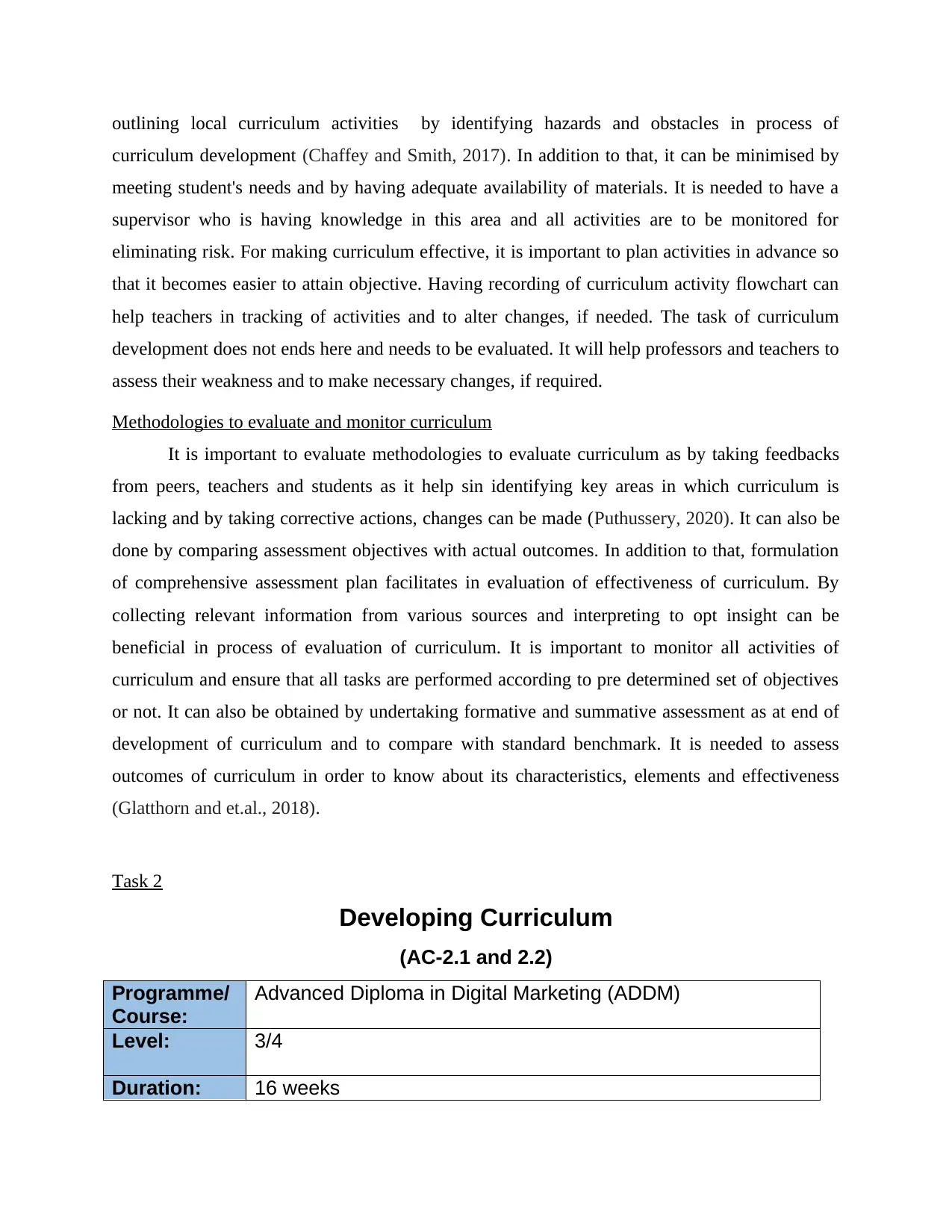
outlining local curriculum activities by identifying hazards and obstacles in process of
curriculum development (Chaffey and Smith, 2017). In addition to that, it can be minimised by
meeting student's needs and by having adequate availability of materials. It is needed to have a
supervisor who is having knowledge in this area and all activities are to be monitored for
eliminating risk. For making curriculum effective, it is important to plan activities in advance so
that it becomes easier to attain objective. Having recording of curriculum activity flowchart can
help teachers in tracking of activities and to alter changes, if needed. The task of curriculum
development does not ends here and needs to be evaluated. It will help professors and teachers to
assess their weakness and to make necessary changes, if required.
Methodologies to evaluate and monitor curriculum
It is important to evaluate methodologies to evaluate curriculum as by taking feedbacks
from peers, teachers and students as it help sin identifying key areas in which curriculum is
lacking and by taking corrective actions, changes can be made (Puthussery, 2020). It can also be
done by comparing assessment objectives with actual outcomes. In addition to that, formulation
of comprehensive assessment plan facilitates in evaluation of effectiveness of curriculum. By
collecting relevant information from various sources and interpreting to opt insight can be
beneficial in process of evaluation of curriculum. It is important to monitor all activities of
curriculum and ensure that all tasks are performed according to pre determined set of objectives
or not. It can also be obtained by undertaking formative and summative assessment as at end of
development of curriculum and to compare with standard benchmark. It is needed to assess
outcomes of curriculum in order to know about its characteristics, elements and effectiveness
(Glatthorn and et.al., 2018).
Task 2
Developing Curriculum
(AC-2.1 and 2.2)
Programme/
Course:
Advanced Diploma in Digital Marketing (ADDM)
Level: 3/4
Duration: 16 weeks
curriculum development (Chaffey and Smith, 2017). In addition to that, it can be minimised by
meeting student's needs and by having adequate availability of materials. It is needed to have a
supervisor who is having knowledge in this area and all activities are to be monitored for
eliminating risk. For making curriculum effective, it is important to plan activities in advance so
that it becomes easier to attain objective. Having recording of curriculum activity flowchart can
help teachers in tracking of activities and to alter changes, if needed. The task of curriculum
development does not ends here and needs to be evaluated. It will help professors and teachers to
assess their weakness and to make necessary changes, if required.
Methodologies to evaluate and monitor curriculum
It is important to evaluate methodologies to evaluate curriculum as by taking feedbacks
from peers, teachers and students as it help sin identifying key areas in which curriculum is
lacking and by taking corrective actions, changes can be made (Puthussery, 2020). It can also be
done by comparing assessment objectives with actual outcomes. In addition to that, formulation
of comprehensive assessment plan facilitates in evaluation of effectiveness of curriculum. By
collecting relevant information from various sources and interpreting to opt insight can be
beneficial in process of evaluation of curriculum. It is important to monitor all activities of
curriculum and ensure that all tasks are performed according to pre determined set of objectives
or not. It can also be obtained by undertaking formative and summative assessment as at end of
development of curriculum and to compare with standard benchmark. It is needed to assess
outcomes of curriculum in order to know about its characteristics, elements and effectiveness
(Glatthorn and et.al., 2018).
Task 2
Developing Curriculum
(AC-2.1 and 2.2)
Programme/
Course:
Advanced Diploma in Digital Marketing (ADDM)
Level: 3/4
Duration: 16 weeks
Paraphrase This Document
Need a fresh take? Get an instant paraphrase of this document with our AI Paraphraser
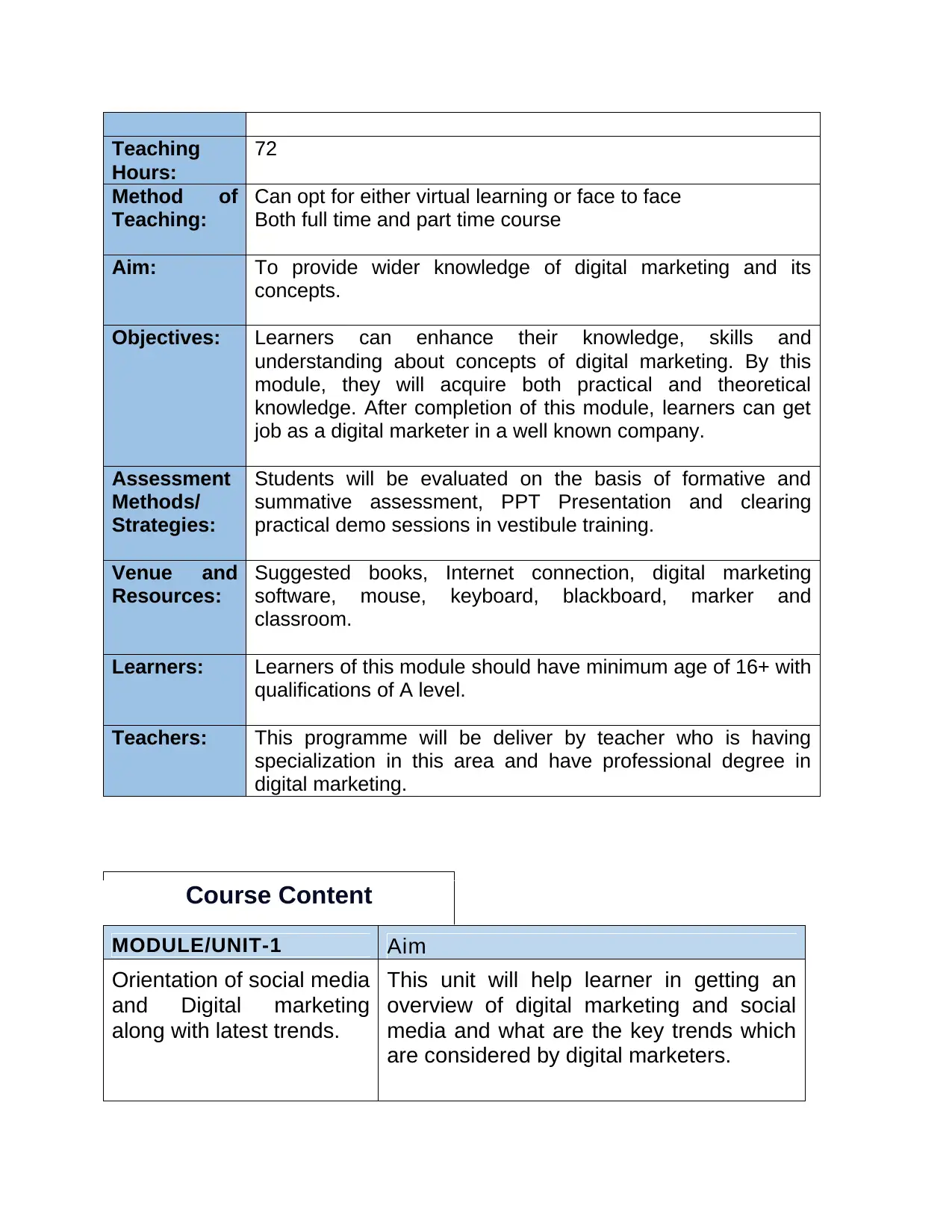
Teaching
Hours:
72
Method of
Teaching:
Can opt for either virtual learning or face to face
Both full time and part time course
Aim: To provide wider knowledge of digital marketing and its
concepts.
Objectives: Learners can enhance their knowledge, skills and
understanding about concepts of digital marketing. By this
module, they will acquire both practical and theoretical
knowledge. After completion of this module, learners can get
job as a digital marketer in a well known company.
Assessment
Methods/
Strategies:
Students will be evaluated on the basis of formative and
summative assessment, PPT Presentation and clearing
practical demo sessions in vestibule training.
Venue and
Resources:
Suggested books, Internet connection, digital marketing
software, mouse, keyboard, blackboard, marker and
classroom.
Learners: Learners of this module should have minimum age of 16+ with
qualifications of A level.
Teachers: This programme will be deliver by teacher who is having
specialization in this area and have professional degree in
digital marketing.
Course Content
MODULE/UNIT-1 Aim
Orientation of social media
and Digital marketing
along with latest trends.
This unit will help learner in getting an
overview of digital marketing and social
media and what are the key trends which
are considered by digital marketers.
Hours:
72
Method of
Teaching:
Can opt for either virtual learning or face to face
Both full time and part time course
Aim: To provide wider knowledge of digital marketing and its
concepts.
Objectives: Learners can enhance their knowledge, skills and
understanding about concepts of digital marketing. By this
module, they will acquire both practical and theoretical
knowledge. After completion of this module, learners can get
job as a digital marketer in a well known company.
Assessment
Methods/
Strategies:
Students will be evaluated on the basis of formative and
summative assessment, PPT Presentation and clearing
practical demo sessions in vestibule training.
Venue and
Resources:
Suggested books, Internet connection, digital marketing
software, mouse, keyboard, blackboard, marker and
classroom.
Learners: Learners of this module should have minimum age of 16+ with
qualifications of A level.
Teachers: This programme will be deliver by teacher who is having
specialization in this area and have professional degree in
digital marketing.
Course Content
MODULE/UNIT-1 Aim
Orientation of social media
and Digital marketing
along with latest trends.
This unit will help learner in getting an
overview of digital marketing and social
media and what are the key trends which
are considered by digital marketers.
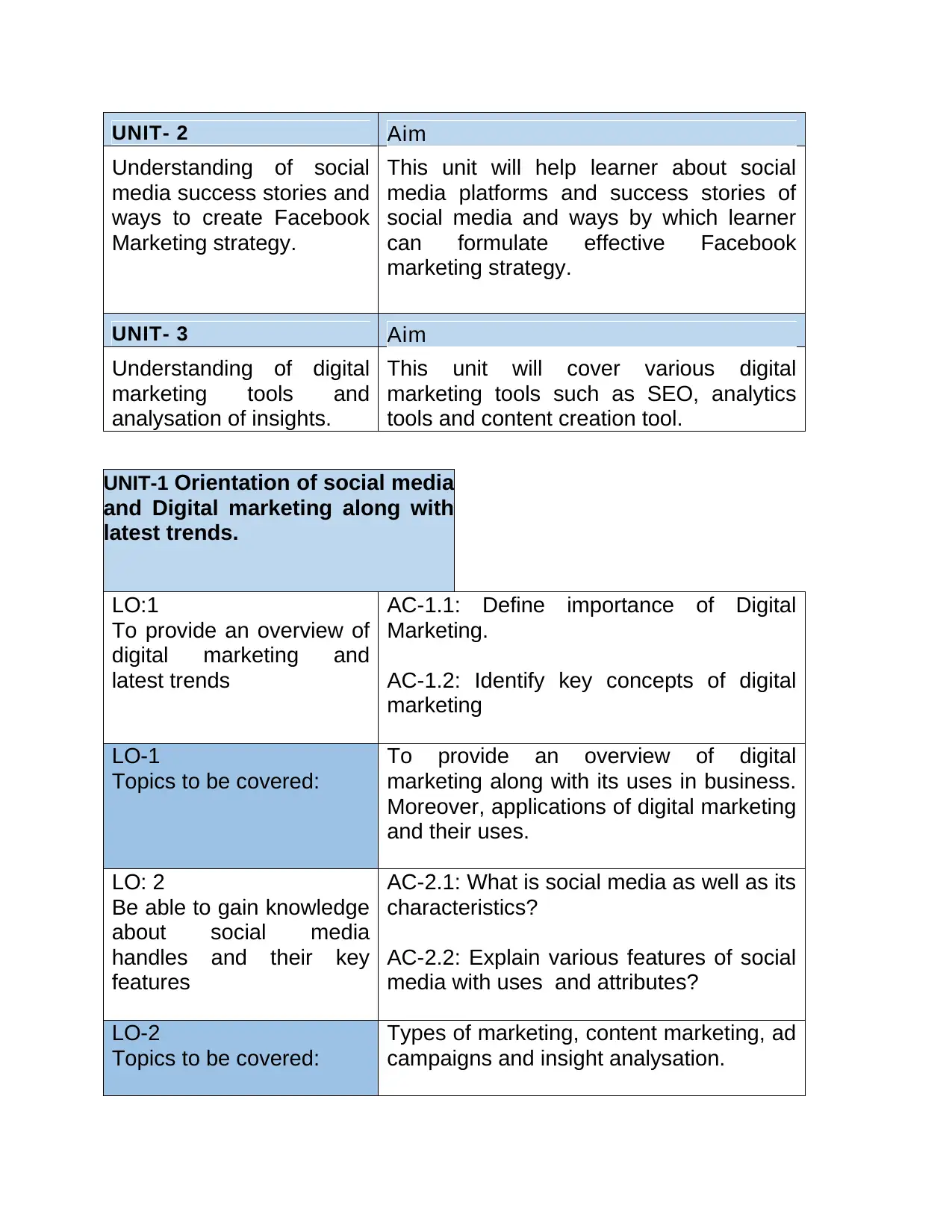
UNIT- 2 Aim
Understanding of social
media success stories and
ways to create Facebook
Marketing strategy.
This unit will help learner about social
media platforms and success stories of
social media and ways by which learner
can formulate effective Facebook
marketing strategy.
UNIT- 3 Aim
Understanding of digital
marketing tools and
analysation of insights.
This unit will cover various digital
marketing tools such as SEO, analytics
tools and content creation tool.
UNIT-1 Orientation of social media
and Digital marketing along with
latest trends.
LO:1
To provide an overview of
digital marketing and
latest trends
AC-1.1: Define importance of Digital
Marketing.
AC-1.2: Identify key concepts of digital
marketing
LO-1
Topics to be covered:
To provide an overview of digital
marketing along with its uses in business.
Moreover, applications of digital marketing
and their uses.
LO: 2
Be able to gain knowledge
about social media
handles and their key
features
AC-2.1: What is social media as well as its
characteristics?
AC-2.2: Explain various features of social
media with uses and attributes?
LO-2
Topics to be covered:
Types of marketing, content marketing, ad
campaigns and insight analysation.
Understanding of social
media success stories and
ways to create Facebook
Marketing strategy.
This unit will help learner about social
media platforms and success stories of
social media and ways by which learner
can formulate effective Facebook
marketing strategy.
UNIT- 3 Aim
Understanding of digital
marketing tools and
analysation of insights.
This unit will cover various digital
marketing tools such as SEO, analytics
tools and content creation tool.
UNIT-1 Orientation of social media
and Digital marketing along with
latest trends.
LO:1
To provide an overview of
digital marketing and
latest trends
AC-1.1: Define importance of Digital
Marketing.
AC-1.2: Identify key concepts of digital
marketing
LO-1
Topics to be covered:
To provide an overview of digital
marketing along with its uses in business.
Moreover, applications of digital marketing
and their uses.
LO: 2
Be able to gain knowledge
about social media
handles and their key
features
AC-2.1: What is social media as well as its
characteristics?
AC-2.2: Explain various features of social
media with uses and attributes?
LO-2
Topics to be covered:
Types of marketing, content marketing, ad
campaigns and insight analysation.
⊘ This is a preview!⊘
Do you want full access?
Subscribe today to unlock all pages.

Trusted by 1+ million students worldwide
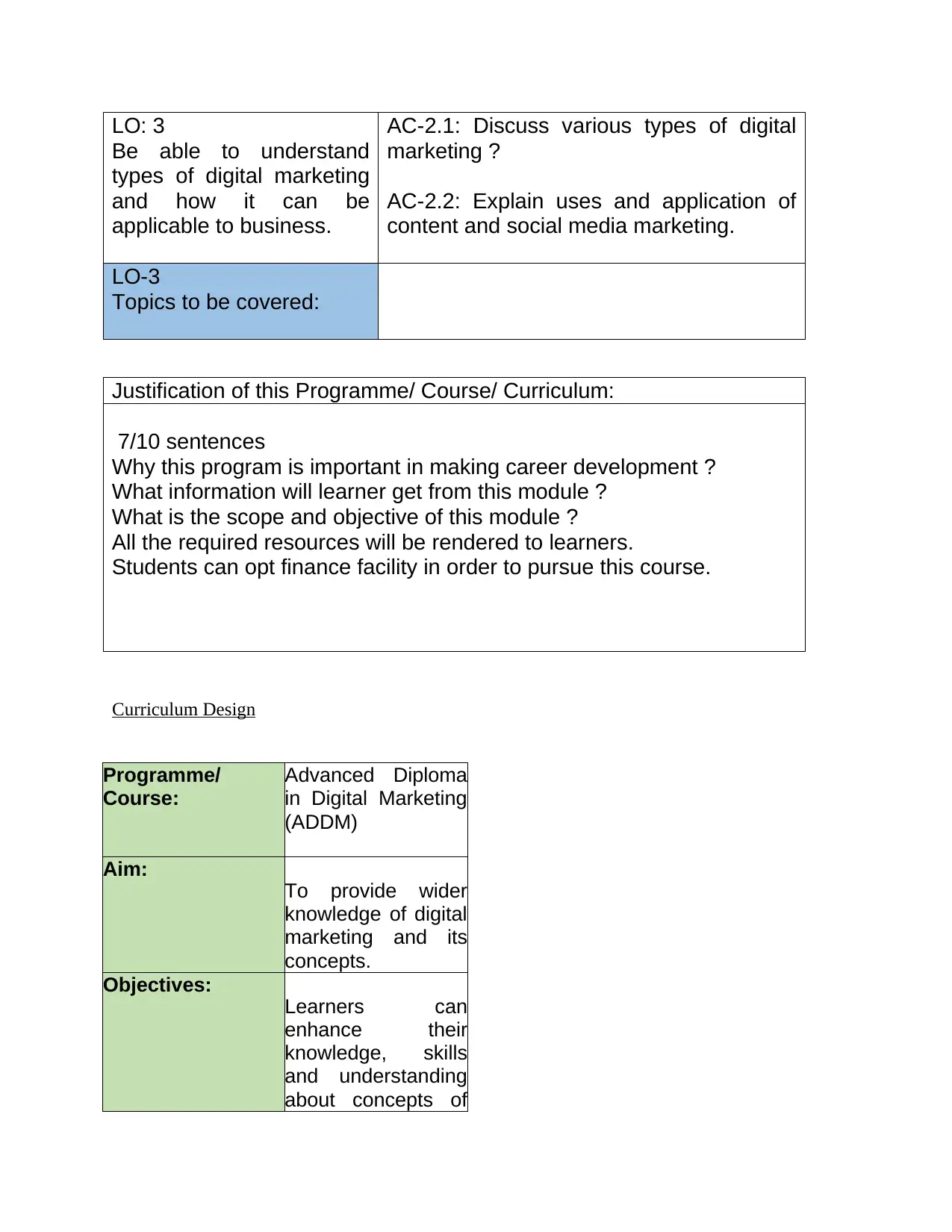
LO: 3
Be able to understand
types of digital marketing
and how it can be
applicable to business.
AC-2.1: Discuss various types of digital
marketing ?
AC-2.2: Explain uses and application of
content and social media marketing.
LO-3
Topics to be covered:
Justification of this Programme/ Course/ Curriculum:
7/10 sentences
Why this program is important in making career development ?
What information will learner get from this module ?
What is the scope and objective of this module ?
All the required resources will be rendered to learners.
Students can opt finance facility in order to pursue this course.
Curriculum Design
Programme/
Course:
Advanced Diploma
in Digital Marketing
(ADDM)
Aim:
To provide wider
knowledge of digital
marketing and its
concepts.
Objectives:
Learners can
enhance their
knowledge, skills
and understanding
about concepts of
Be able to understand
types of digital marketing
and how it can be
applicable to business.
AC-2.1: Discuss various types of digital
marketing ?
AC-2.2: Explain uses and application of
content and social media marketing.
LO-3
Topics to be covered:
Justification of this Programme/ Course/ Curriculum:
7/10 sentences
Why this program is important in making career development ?
What information will learner get from this module ?
What is the scope and objective of this module ?
All the required resources will be rendered to learners.
Students can opt finance facility in order to pursue this course.
Curriculum Design
Programme/
Course:
Advanced Diploma
in Digital Marketing
(ADDM)
Aim:
To provide wider
knowledge of digital
marketing and its
concepts.
Objectives:
Learners can
enhance their
knowledge, skills
and understanding
about concepts of
Paraphrase This Document
Need a fresh take? Get an instant paraphrase of this document with our AI Paraphraser
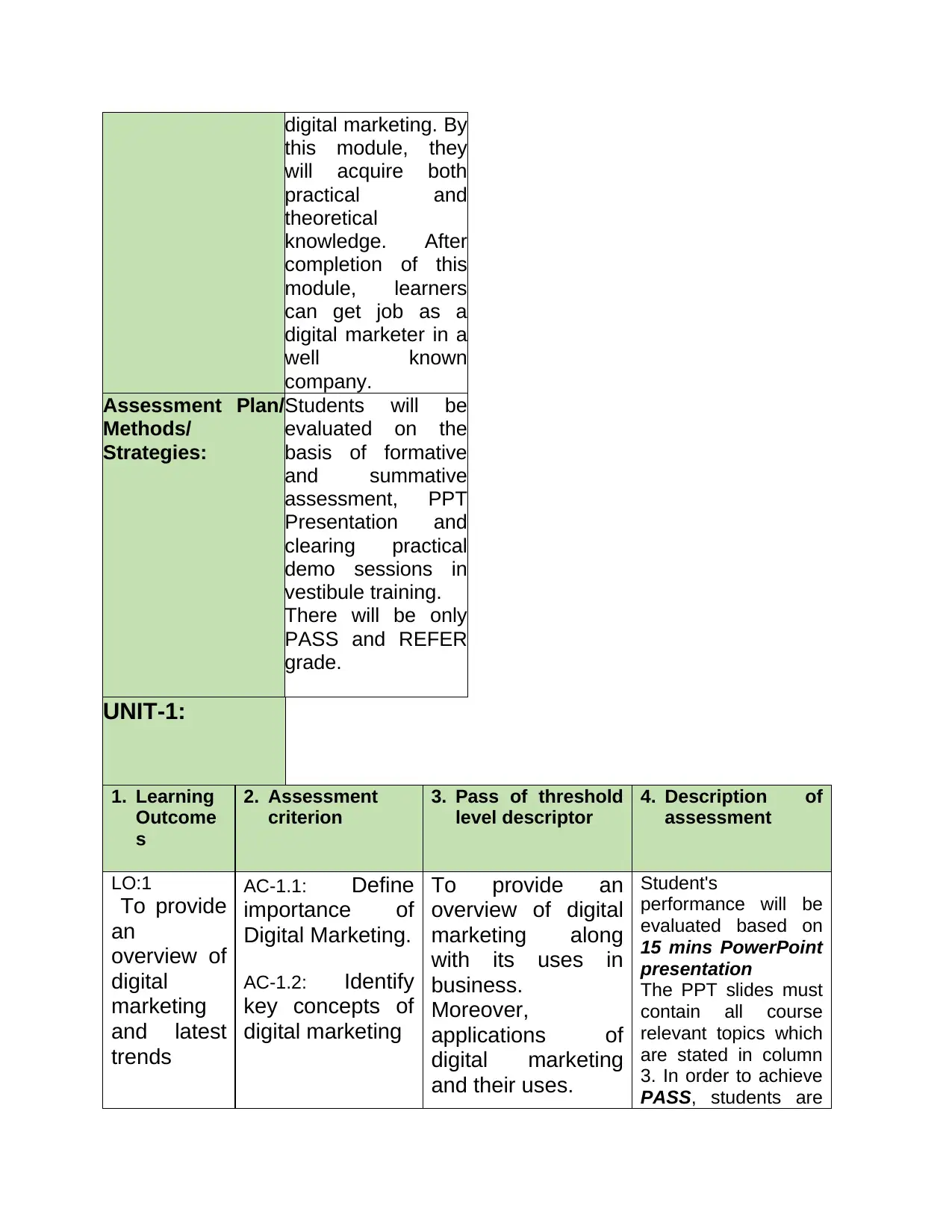
digital marketing. By
this module, they
will acquire both
practical and
theoretical
knowledge. After
completion of this
module, learners
can get job as a
digital marketer in a
well known
company.
Assessment Plan/
Methods/
Strategies:
Students will be
evaluated on the
basis of formative
and summative
assessment, PPT
Presentation and
clearing practical
demo sessions in
vestibule training.
There will be only
PASS and REFER
grade.
UNIT-1:
1. Learning
Outcome
s
2. Assessment
criterion
3. Pass of threshold
level descriptor
4. Description of
assessment
LO:1
To provide
an
overview of
digital
marketing
and latest
trends
AC-1.1: Define
importance of
Digital Marketing.
AC-1.2: Identify
key concepts of
digital marketing
To provide an
overview of digital
marketing along
with its uses in
business.
Moreover,
applications of
digital marketing
and their uses.
Student's
performance will be
evaluated based on
15 mins PowerPoint
presentation
The PPT slides must
contain all course
relevant topics which
are stated in column
3. In order to achieve
PASS, students are
this module, they
will acquire both
practical and
theoretical
knowledge. After
completion of this
module, learners
can get job as a
digital marketer in a
well known
company.
Assessment Plan/
Methods/
Strategies:
Students will be
evaluated on the
basis of formative
and summative
assessment, PPT
Presentation and
clearing practical
demo sessions in
vestibule training.
There will be only
PASS and REFER
grade.
UNIT-1:
1. Learning
Outcome
s
2. Assessment
criterion
3. Pass of threshold
level descriptor
4. Description of
assessment
LO:1
To provide
an
overview of
digital
marketing
and latest
trends
AC-1.1: Define
importance of
Digital Marketing.
AC-1.2: Identify
key concepts of
digital marketing
To provide an
overview of digital
marketing along
with its uses in
business.
Moreover,
applications of
digital marketing
and their uses.
Student's
performance will be
evaluated based on
15 mins PowerPoint
presentation
The PPT slides must
contain all course
relevant topics which
are stated in column
3. In order to achieve
PASS, students are
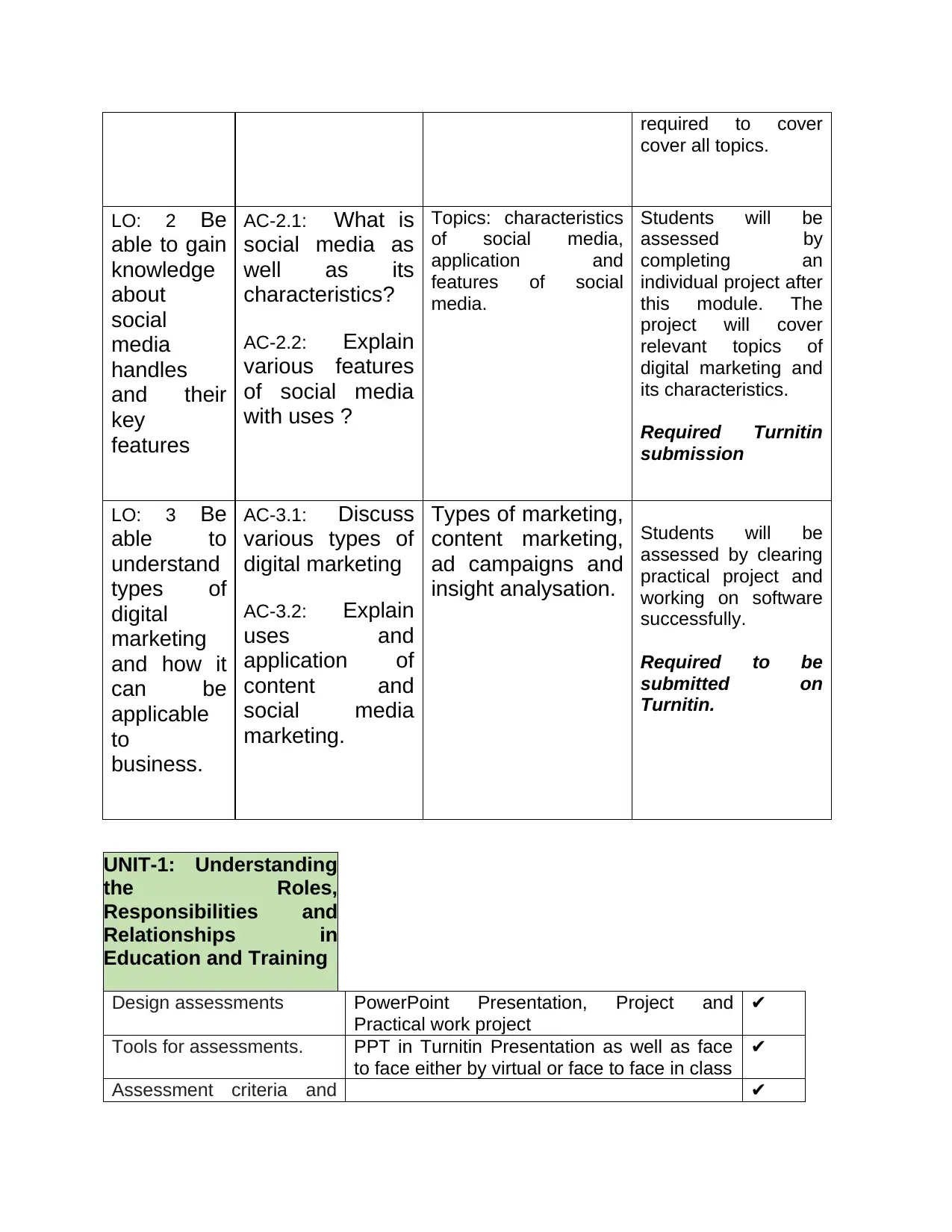
required to cover
cover all topics.
LO: 2 Be
able to gain
knowledge
about
social
media
handles
and their
key
features
AC-2.1: What is
social media as
well as its
characteristics?
AC-2.2: Explain
various features
of social media
with uses ?
Topics: characteristics
of social media,
application and
features of social
media.
Students will be
assessed by
completing an
individual project after
this module. The
project will cover
relevant topics of
digital marketing and
its characteristics.
Required Turnitin
submission
LO: 3 Be
able to
understand
types of
digital
marketing
and how it
can be
applicable
to
business.
AC-3.1: Discuss
various types of
digital marketing
AC-3.2: Explain
uses and
application of
content and
social media
marketing.
Types of marketing,
content marketing,
ad campaigns and
insight analysation.
Students will be
assessed by clearing
practical project and
working on software
successfully.
Required to be
submitted on
Turnitin.
UNIT-1: Understanding
the Roles,
Responsibilities and
Relationships in
Education and Training
Design assessments PowerPoint Presentation, Project and
Practical work project
✔
Tools for assessments. PPT in Turnitin Presentation as well as face
to face either by virtual or face to face in class
✔
Assessment criteria and ✔
cover all topics.
LO: 2 Be
able to gain
knowledge
about
social
media
handles
and their
key
features
AC-2.1: What is
social media as
well as its
characteristics?
AC-2.2: Explain
various features
of social media
with uses ?
Topics: characteristics
of social media,
application and
features of social
media.
Students will be
assessed by
completing an
individual project after
this module. The
project will cover
relevant topics of
digital marketing and
its characteristics.
Required Turnitin
submission
LO: 3 Be
able to
understand
types of
digital
marketing
and how it
can be
applicable
to
business.
AC-3.1: Discuss
various types of
digital marketing
AC-3.2: Explain
uses and
application of
content and
social media
marketing.
Types of marketing,
content marketing,
ad campaigns and
insight analysation.
Students will be
assessed by clearing
practical project and
working on software
successfully.
Required to be
submitted on
Turnitin.
UNIT-1: Understanding
the Roles,
Responsibilities and
Relationships in
Education and Training
Design assessments PowerPoint Presentation, Project and
Practical work project
✔
Tools for assessments. PPT in Turnitin Presentation as well as face
to face either by virtual or face to face in class
✔
Assessment criteria and ✔
⊘ This is a preview!⊘
Do you want full access?
Subscribe today to unlock all pages.

Trusted by 1+ million students worldwide
1 out of 21
Related Documents
Your All-in-One AI-Powered Toolkit for Academic Success.
+13062052269
info@desklib.com
Available 24*7 on WhatsApp / Email
![[object Object]](/_next/static/media/star-bottom.7253800d.svg)
Unlock your academic potential
Copyright © 2020–2025 A2Z Services. All Rights Reserved. Developed and managed by ZUCOL.



